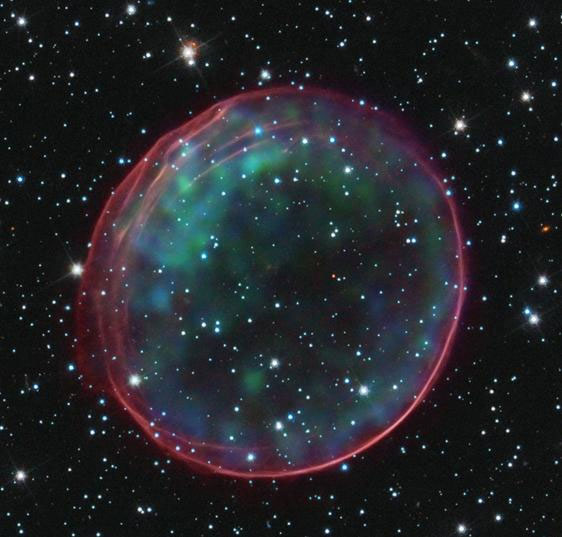Supernova origin
With the Hubble Space Telescope, astronomers have lifted the long-standing mysterious veil of a star form, or its predecessor, to cause a supernova explosion in a galaxy next to us. . This finding focuses on new observational data to determine the location of one of several cases that triggered similar large explosions.
>>>Unprecedented discovery of supernovae
Based on previous observations from ground telescopes, astronomers learned that a kind of explosion, called the Ia star explosion , had left ruins with the name SNR 0509-67.5 from the earth. 170 thousand light years of the Large Magellanic Cloud (one of the two small galaxies orbiting the Milky Way, can be seen from Antarctica).
The system that led to this supernova explosion has long been an important issue with many solutions, but there is no definite solution. These solutions all suggest that a white dwarf in some way swells to the extreme.
Astronomers could not find any companion stars near the center of the ruins, according to the rule of elimination, the only possibility is the stellar Ia form originating from a pair of orbiting white dwarfs. adjacent.
'We all know the Hubble telescope is sensitive enough to detect the faintest remnants of white dwarfs that have caused explosions ,' said Bradley Schaefer of Louisiana State University (LSU) Baton Rouge, leading the survey team. "Logics here as well as Sherlock Holmes once said: After eliminating impossible possibilities, what remains, though unlikely, is true."

Scientists can give the most convincing explanation of the cause of the formation of SNR 0509-67.5, with two white dwarfs following the spiraling trajectory increasingly close together until they collide and explode.
For the past four decades, searching for the precursor to supernova explosions is a key issue in astrophysics. This problem became a special concern in the last decade when the stellar Ia form became the leading tool for measuring the accelerating universe.
Exploding star type Ia, with tremendous explosion energy, light emission is even brighter than a starry galaxy. Responding to this problem requires clarifying the mechanism that has pushed the mass of white dwarfs to the peak and activated this type of explosion. There are many proposals, but most require a companion star near the exploding star area to survive after the explosion. Therefore, the feasible way to distinguish between the different precursor models is to look deep into the center of the remnant of the stellar explosion to find a companion star.
In 2010, when Schaefer and Ashley Pagnotta from the University of Louisiana were preparing to propose any very fuzzy companion stars in the ruins of the four stellar regions in the Great Magellanic Cloud, they discovered glass. Hubble space astronomy once captured the desired image of one of the four ruins, SNR 0509-67.5, in the Hubble Telescope Successor Program. This program collects special photos of the astronomical points that Hubble captures.
When analyzing the central region, they realized that there was no star on the image even at the most fuzzy limit that Hubble could detect. Schaefer announced that only the best solution would be the 'paired degenerate model' , or so, with two white dwarfs colliding.
No observational data on the star is exploding. However, researchers at the Space Telescope Science Institute in Baltimore, Maryland, have identified light from this stellar explosion, which reflects on interstellar dust clouds and reaches Earth later than 400 years. . The slow arrival of light, called the supernova explosion , has also allowed astronomers to measure the signal of the light spectrum of the explosion. Thanks to the pure color sign, astronomers have proved it to be a stellar explosion.
Because the ruins look like a beautiful shell or bubble, its geometric center can be determined accurately. These properties make SNR 0509-67.5 an ideal target to find companion stars. Its young age also means that the stars have yet to go far from the explosion zone.
The team plans to observe other stellar explosions in the Large Magellanic Cloud to further examine their observations.
- Build 3D core map of a supernova
- Core Earth originated from supernova?
- Learn about supernovae and supernovae
- Discover new supernova
- Photos, videos and three-dimensional models of giant supernova
- Create supernova explosions in the laboratory
- The supernova explosion is 10.5 billion light-years away from Earth
- The supernova is 20 times brighter than the Milky Way
- The first evidence of the origin of cosmic dust formation
- Discover new forms of supernovae
- Earth used to catch supernova dust
- NuSTAR telescope helps decode supernova explosions
 Van Allen's belt and evidence that the Apollo 11 mission to the Moon was myth
Van Allen's belt and evidence that the Apollo 11 mission to the Moon was myth The levels of civilization in the universe (Kardashev scale)
The levels of civilization in the universe (Kardashev scale) Today Mars, the sun and the Earth are aligned
Today Mars, the sun and the Earth are aligned The Amazon owner announced a secret plan to build a space base for thousands of people
The Amazon owner announced a secret plan to build a space base for thousands of people